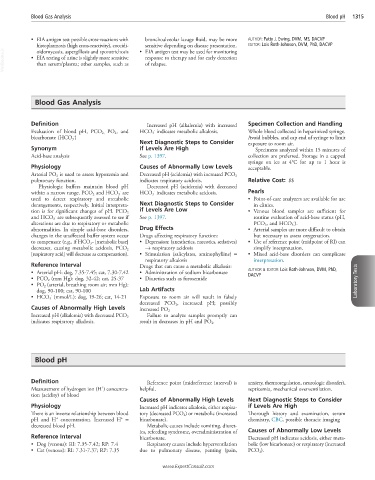Page 2598 - Cote clinical veterinary advisor dogs and cats 4th
P. 2598
Blood Gas Analysis Blood pH 1315
• EIA antigen test possible cross-reactions with bronchoalveolar lavage fluid, may be more AUTHOR: Patty J. Ewing, DVM, MS, DACVP
sensitive depending on disease presentation.
histoplasmosis (high cross-reactivity), coccidi- • EIA antigen test may be used for monitoring EDITOR: Lois Roth-Johnson, DVM, PhD, DACVP
VetBooks.ir • EIA testing of urine is slightly more sensitive response to therapy and for early detection
oidomycosis, aspergillosis and sporotrichosis
than serum/plasma; other samples, such as
of relapse.
Blood Gas Analysis
Definition Increased pH (alkalemia) with increased Specimen Collection and Handling
-
Evaluation of blood pH, PCO 2, PO 2 , and HCO 3 indicates metabolic alkalosis. Whole blood collected in heparinized syringe.
bicarbonate (HCO 3 ) - Avoid bubbles, and cap end of syringe to limit
Next Diagnostic Steps to Consider exposure to room air.
Synonym if Levels Are High Specimens analyzed within 15 minutes of
Acid-base analysis See p. 1397. collection are preferred. Storage in a capped
syringe on ice at 4°C for up to 1 hour is
Physiology Causes of Abnormally Low Levels acceptable.
Arterial PO 2 is used to assess hypoxemia and Decreased pH (acidemia) with increased PCO 2
pulmonary function. indicates respiratory acidosis. Relative Cost: $$
Physiologic buffers maintain blood pH Decreased pH (acidemia) with decreased
-
-
within a narrow range. PCO 2 and HCO 3 are HCO 3 indicates metabolic acidosis. Pearls
used to detect respiratory and metabolic • Point-of-care analyzers are available for use
derangements, respectively. Initial interpreta- Next Diagnostic Steps to Consider in clinics.
tion is for significant changes of pH. PCO 2 if Levels Are Low • Venous blood samples are sufficient for
-
and HCO 3 are subsequently assessed to see if See p. 1397. routine evaluation of acid-base status (pH,
-
alterations are due to respiratory or metabolic PCO 2 , and HCO 3 ).
abnormalities. In simple acid-base disorders, Drug Effects • Arterial samples are more difficult to obtain
changes in the unaffected buffer system occur Drugs affecting respiratory function: but necessary to assess oxygenation.
to compensate (e.g., if HCO 3 - [metabolic base] • Depression: (anesthetics, narcotics, sedatives) • Use of reference point (midpoint of RI) can
decreases, causing metabolic acidosis, PCO 2 → respiratory acidosis simplify interpretation.
[respiratory acid] will decrease as compensation). • Stimulation (salicylates, aminophylline) = • Mixed acid-base disorders can complicate
respiratory alkalosis interpretation.
Reference Interval Drugs that can cause a metabolic alkalosis:
• Arterial pH: dog, 7.35-7.45; cat, 7.30-7.42 • Administration of sodium bicarbonate AUTHOR & EDITOR: Lois Roth-Johnson, DVM, PhD,
DACVP
• PCO 2 (mm Hg): dog, 32-42; cat, 25-37 • Diuretics such as furosemide Laboratory Tests
• PO 2 (arterial, breathing room air; mm Hg):
dog, 90-100; cat, 90-100 Lab Artifacts
-
• HCO 3 (mmol/L): dog, 19-26; cat, 14-21 Exposure to room air will result in falsely
decreased PCO 2 , increased pH; possibly
Causes of Abnormally High Levels increased PO 2
Increased pH (alkalemia) with decreased PCO 2 Failure to analyze samples promptly can
indicates respiratory alkalosis. result in decreases in pH and PO 2.
Blood pH
Definition Reference point (midreference interval) is anxiety, thermoregulation, neurologic disorder),
+
Measurement of hydrogen ion (H ) concentra- helpful. septicemia, mechanical overventilation.
tion (acidity) of blood
Causes of Abnormally High Levels Next Diagnostic Steps to Consider
Physiology Increased pH indicates alkalosis, either respira- if Levels Are High
There is an inverse relationship between blood tory (decreased PCO 2 ) or metabolic (increased Thorough history and examination, serum
+
+
pH and H concentration. Increased H = bicarbonate). chemistry, CBC, possible thoracic imaging
decreased blood pH. Metabolic causes include vomiting, diuret-
ics, refeeding syndrome, overadministration of Causes of Abnormally Low Levels
Reference Interval bicarbonate. Decreased pH indicates acidosis, either meta-
• Dog (venous): RI: 7.35-7.42; RP: 7.4 Respiratory causes include hyperventilation bolic (low bicarbonate) or respiratory (increased
• Cat (venous): RI: 7.31-7.37; RP: 7.35 due to pulmonary disease, panting (pain, PCO 2 ).
www.ExpertConsult.com

